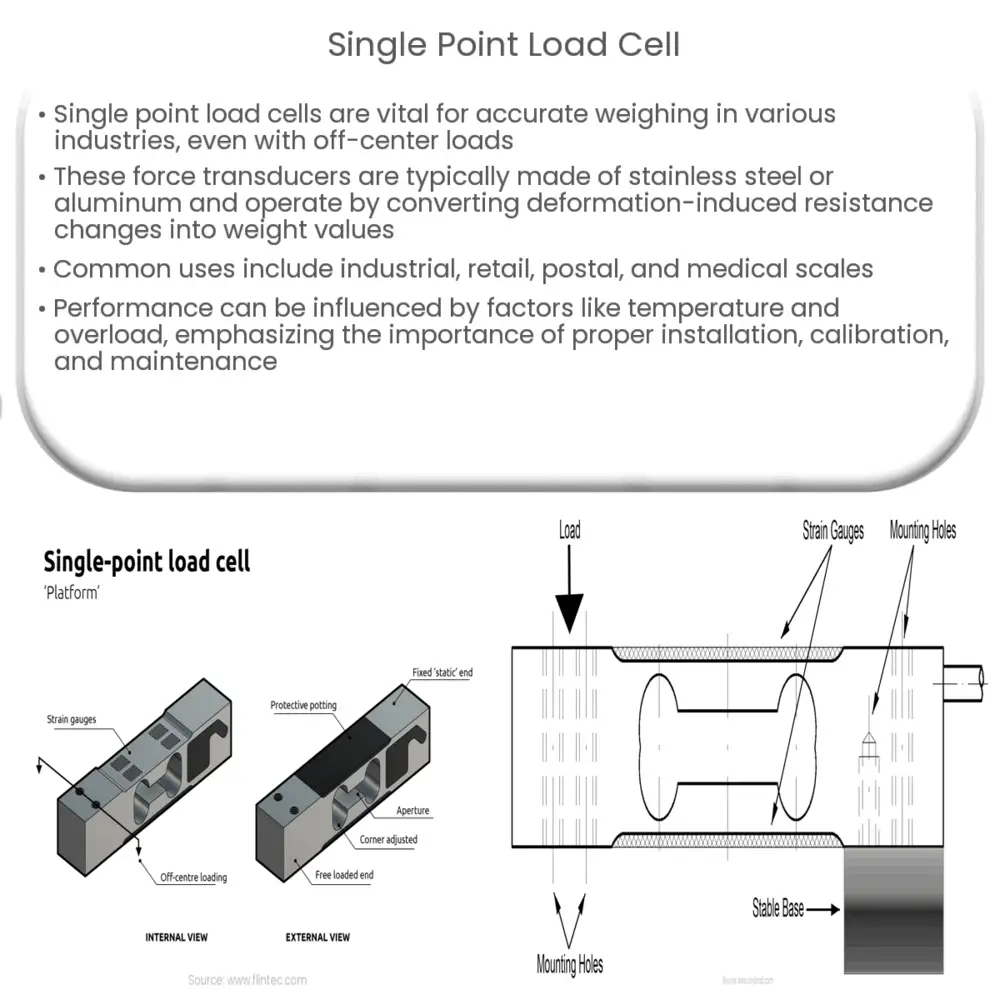Single point load cells accurately measure off-center loads, widely used in industrial, retail, postal, and medical scales for precision weighing.

Single Point Load Cells: An Overview
Single point load cells are a crucial component in the world of weighing systems, playing an essential role in many industrial and commercial applications. This article will provide an overview of single point load cells, their construction, working principle, and common applications. In the next part, we will dive deeper into the factors that influence the performance and accuracy of these devices.
What are Single Point Load Cells?
Single point load cells, also known as platform load cells or beam type load cells, are a type of force transducer specifically designed to measure off-center loads on a single weighing platform. They are characterized by their ability to provide accurate and consistent weight measurements, even when the load is not perfectly centered on the platform. This makes them ideal for applications requiring high accuracy and precision over a wide range of load distributions.
Construction and Working Principle
Typically, single point load cells are constructed from either stainless steel or aluminum, materials that offer excellent resistance to corrosion and high levels of durability. The main component of the load cell is a strain gauge, which is a thin, flexible electrical conductor that changes its electrical resistance as it is stretched or compressed. The strain gauge is usually bonded to a metal element called the sensing element, which undergoes deformation as the load is applied.
When a load is placed on the weighing platform, it causes the sensing element to deform, subsequently changing the strain gauge’s electrical resistance. This change in resistance is proportional to the applied load and is converted into an electrical signal, which can be further processed and displayed as a weight value.
Common Applications
Single point load cells are widely used in various industries due to their versatility, high accuracy, and the ability to handle off-center loads. Some common applications include:
- Industrial Scales: In manufacturing and production facilities, single point load cells are used in industrial scales to weigh raw materials, finished products, and other items throughout the production process.
- Retail Scales: Retail scales, such as those found in grocery stores and supermarkets, rely on single point load cells to provide precise weight measurements for pricing and inventory management purposes.
- Postal Scales: Postal scales use single point load cells to accurately weigh packages and letters, ensuring the correct postage is applied and helping to streamline the shipping process.
- Medical Scales: In healthcare settings, single point load cells are used in patient scales to monitor weight changes and track health progress.
In the next part of this article, we will explore the factors that influence the performance and accuracy of single point load cells, as well as the best practices for their installation and calibration.
Factors Influencing Performance and Accuracy
Several factors can impact the performance and accuracy of single point load cells. Some of these factors include:
- Temperature: Temperature variations can cause changes in the load cell’s material properties, leading to fluctuations in the electrical resistance of the strain gauge. To minimize temperature-related errors, many load cells incorporate temperature compensation techniques.
- Overload and Shock: Excessive loads or sudden impacts can permanently damage the load cell, leading to inaccurate readings or complete failure. Using overload protection devices and proper mounting can help prevent damage from overloads and shocks.
- Creep: Creep is the gradual change in output signal over time when a constant load is applied. This phenomenon can result in measurement errors, particularly in applications requiring long-term stability. Load cell manufacturers often specify the creep performance of their products, allowing users to select a suitable device for their application.
- Electrical Interference: Electromagnetic interference from nearby equipment or cables can affect the load cell’s output signal. Using shielded cables and proper grounding can help mitigate electrical interference.
Installation and Calibration Best Practices
To ensure optimal performance and accuracy, it is essential to follow the manufacturer’s guidelines for installing and calibrating single point load cells. Some general best practices include:
- Mounting: Ensure the load cell is mounted on a stable, flat, and rigid surface to minimize errors due to uneven loading or vibration. Additionally, use appropriate mounting hardware to secure the load cell in place.
- Alignment: Proper alignment of the load cell and the weighing platform is crucial for accurate weight measurements. Follow the manufacturer’s recommendations for aligning the load cell with the platform.
- Calibration: Regular calibration is essential to maintain the accuracy and reliability of the load cell. Use a known, traceable calibration weight to check the load cell’s output signal and adjust it as necessary. Follow the manufacturer’s guidelines for calibration frequency and procedures.
- Maintenance: Regularly inspect the load cell for signs of wear, damage, or corrosion. Keep the load cell and weighing platform clean and free from debris to ensure consistent performance.
Conclusion
Single point load cells are indispensable components in many weighing applications, offering high accuracy and the ability to handle off-center loads. By understanding their construction, working principle, and common applications, users can make informed decisions when selecting and implementing these devices. Additionally, by considering the factors that influence their performance and following best practices for installation and calibration, users can ensure the reliability and accuracy of their weighing systems for years to come.

